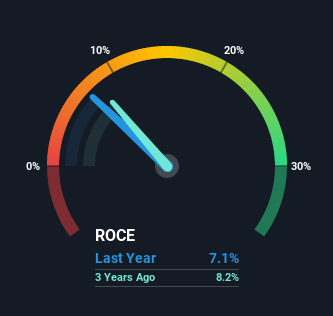- Singapore
- /
- Trade Distributors
- /
- SGX:5VS
Returns On Capital At Hafary Holdings (SGX:5VS) Have Hit The Brakes
If you're looking for a multi-bagger, there's a few things to keep an eye out for. Firstly, we'd want to identify a growing return on capital employed (ROCE) and then alongside that, an ever-increasing base of capital employed. If you see this, it typically means it's a company with a great business model and plenty of profitable reinvestment opportunities. However, after briefly looking over the numbers, we don't think Hafary Holdings (SGX:5VS) has the makings of a multi-bagger going forward, but let's have a look at why that may be.
What is Return On Capital Employed (ROCE)?
Just to clarify if you're unsure, ROCE is a metric for evaluating how much pre-tax income (in percentage terms) a company earns on the capital invested in its business. The formula for this calculation on Hafary Holdings is:
Return on Capital Employed = Earnings Before Interest and Tax (EBIT) ÷ (Total Assets - Current Liabilities)
0.071 = S$13m ÷ (S$251m - S$71m) (Based on the trailing twelve months to June 2021).
Thus, Hafary Holdings has an ROCE of 7.1%. On its own that's a low return on capital but it's in line with the industry's average returns of 6.6%.
View our latest analysis for Hafary Holdings

Historical performance is a great place to start when researching a stock so above you can see the gauge for Hafary Holdings' ROCE against it's prior returns. If you'd like to look at how Hafary Holdings has performed in the past in other metrics, you can view this free graph of past earnings, revenue and cash flow.
What Can We Tell From Hafary Holdings' ROCE Trend?
In terms of Hafary Holdings' historical ROCE trend, it doesn't exactly demand attention. The company has employed 31% more capital in the last five years, and the returns on that capital have remained stable at 7.1%. Given the company has increased the amount of capital employed, it appears the investments that have been made simply don't provide a high return on capital.
Our Take On Hafary Holdings' ROCE
In conclusion, Hafary Holdings has been investing more capital into the business, but returns on that capital haven't increased. Since the stock has gained an impressive 58% over the last five years, investors must think there's better things to come. Ultimately, if the underlying trends persist, we wouldn't hold our breath on it being a multi-bagger going forward.
One final note, you should learn about the 5 warning signs we've spotted with Hafary Holdings (including 2 which are potentially serious) .
While Hafary Holdings may not currently earn the highest returns, we've compiled a list of companies that currently earn more than 25% return on equity. Check out this free list here.
Valuation is complex, but we're here to simplify it.
Discover if Hafary Holdings might be undervalued or overvalued with our detailed analysis, featuring fair value estimates, potential risks, dividends, insider trades, and its financial condition.
Access Free AnalysisThis article by Simply Wall St is general in nature. We provide commentary based on historical data and analyst forecasts only using an unbiased methodology and our articles are not intended to be financial advice. It does not constitute a recommendation to buy or sell any stock, and does not take account of your objectives, or your financial situation. We aim to bring you long-term focused analysis driven by fundamental data. Note that our analysis may not factor in the latest price-sensitive company announcements or qualitative material. Simply Wall St has no position in any stocks mentioned.
Have feedback on this article? Concerned about the content? Get in touch with us directly. Alternatively, email editorial-team (at) simplywallst.com.
About SGX:5VS
Hafary Holdings
An investment holding company, engages in import, export, dealing, distribution, wholesale, and trading in building materials.
Good value with adequate balance sheet and pays a dividend.
Market Insights
Community Narratives


Recently Updated Narratives

Constellation Energy Dividends and Growth

CoreWeave's Revenue Expected to Rocket 77.88% in 5-Year Forecast

Bisalloy Steel Group will shine with a projected profit margin increase of 12.8%
Popular Narratives


MicroVision will explode future revenue by 380.37% with a vision towards success


NVDA: Expanding AI Demand Will Drive Major Data Center Investments Through 2026



